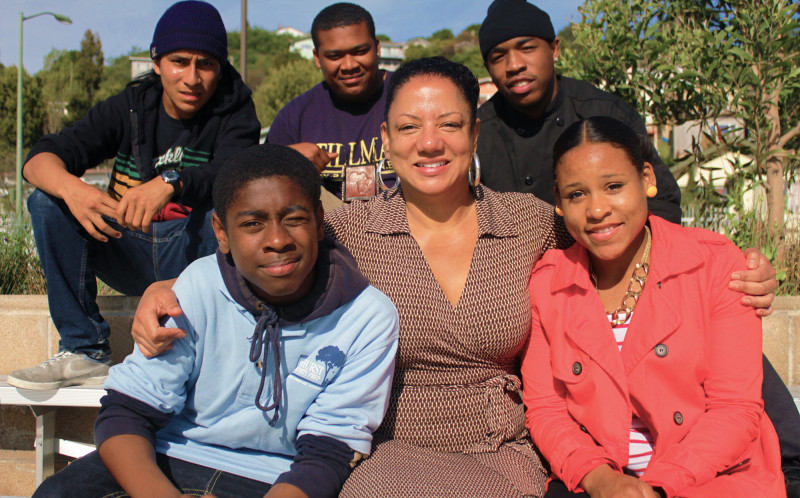But she understands why this place was called that. "Certainly what’s happened in this neighborhood has been a massacre," she said. "It’s been black-on-black crime."
It was actually fights between black and Latino students at Castlemont High School, right next door, that caused the city and the community to lobby and create the youth center. Simmons said the media called it a race riot, which she says it wasn't. But maybe it doesn't matter exactly why it started. Simmons said what matters is how it started, a process driven by the ideas of the same young people it was built to serve.
Before Youth Uprising took over the space that was once an abandoned Safeway supermarket, there were few, if any, safe places for young people in East Oakland to just hang out.
Youth Uprising was built to fill that void. "Our job was to actually breathe hope and life back into the neighborhood," Simmons said. "By working with the young people that most people are afraid of, the 13- to 24-year olds that are hanging out on the street."
And she said that’s what she did, case by case, and kid by kid.
Simmons is the first to acknowledge that the stretch of land where Youth Uprising stands -- on the corner of MacArthur Boulevard and 88th Avenue -- looks pretty much the same as it did when she began her work here: a few boarded-up businesses and boxlike apartments.
There are no hard statistics that show how Simmons and Youth Uprising transformed the neighborhood, and there are criticisms that this multimillion-dollar youth center didn’t do all that was promised.
The dropout rate is still high here. Young people who are born and live here are still more likely to be born into poverty and to encounter violence.
But Simmons said it was a history of disinvestment that caused this once thriving middle-class African-American enclave to become a place called "the killing fields." The building of the MacArthur Freeway in the 1960s devastated businesses by eliminating through traffic, as freeways did in so many urban corridors. White flight and redlining and the introduction of crack cocaine, followed by the war on drugs, all combined to traumatize this neighborhood. The primarily black residents here faced the brunt of this disinvestment.
Youth Uprising, Simmons said, has been around only 13 years.
"When we were in planning and when we opened, the question was: Could this neighborhood be revitalized?" she said.
Now, as gentrification spreads across Oakland, the stakes have changed.
"The question now is when the neighborhood is revitalized -- because it’s not if, it’s when -- who will it be revitalized for?" she said.
Gentrification and the black displacement that comes with it have already hit most of the city. Simmons sees it arriving here now, in deep East Oakland.
That means the kids who Youth Uprising was built to serve may not be around when the neighborhood actually gets better -- when the boarded-up storefronts are replaced with real stores.
Simmons is aware that a single youth center, however well-funded and beloved, cannot be a single savior. Too many other forces are at work.
That is why in recent years she tried to expand Youth Uprising's mission. But her attempts have fallen short. The charter schools she opened could not enroll enough students to continue and ran out of money.
She also wanted to create low-income housing here, to make it possible for the residents of East Oakland to stay in the neighborhood where they were born. That endeavor, she said, faced roadblocks as well.
In 2017, an Alameda County civil grand jury audit found the nonprofit was operating in the red and was bailed out by the city of Oakland.
"It’s never an easy road," Simmons said. "There’s never a point in that struggle for economic and racial justice where you think, 'Wow, this is easy.' But I do think you have to bring to it a passion and a fire ... that I don’t know that I’ve got anymore."
At age 57, and after working her whole life, she is tired, she said.
In 2016, Simmons' mother died. That loss made her think about what she wants to do with her life, going forward.
For now, she said, it’s time to exit stage left.
Simmons is not universally beloved. Some have claimed the failure of the charter schools, and the inability to get the affordable housing project off the ground, were a result of mismanagement. Simmons said the reality is far more complicated.
Critics also cite her for making too much money for someone running a center serving primarily poor black youth. According to the grand jury audit, from 2011-2014 Simmons made $217,700 a year.
"The criticism of my salary has always been fascinating to me," she said.
Her response is twofold. For one, she said, she makes an average nonprofit CEO’s salary -- based on the size of the organization and where it’s located. She didn't set her salary, she said. The Youth Uprising board did.
Her second argument is more nuanced. She wants to model the fact that a black woman, doing good work in the community, doesn't have to be hungry. Why shouldn't she show her kids -- the Youth Uprising kids -- that you can give back, and not suffer for it?
The same board that set her salary will now work to decide who will succeed her as the head of Youth Uprising. Simmons said they are conducting a nationwide search.
As Simmons and I are talking, a young man comes up to her office window, and taps on it.
He presses a piece of paper up against the glass. On it he's written: "I love Olis."
"I love you, too," Simmons said, laughing.


